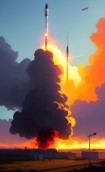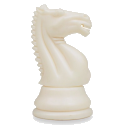|
A semi-effort post on a late Cold War air defense system, Patriot. Patriot successfully engaged its first drone target in 1975. It was initially fielded as a highly accurate, highly maneuverable, long range, high altitude, mobile anti-aircraft system. All families of Patriot missile except the PAC-3 (Patriot Advanced Capability) are proximity kill missiles with an approximately 200 pound warhead which spreads a cloud of steel fragments. It is extremely effective, even against maneuvering targets and high speed aircraft. The system is comprised of a radar, EPP (electric power plant), ECS (Engagement Control Station), AMG (Antenna Mast Group), and up to 16 launchers, some of which can be at a remote site if additional communications architecture is added to the system. Each launcher can hold 4 missiles of the PAC-2 or older family. Each PAC-3 launcher can hold 16 missiles. The system is a command guidance, track via missile system. The missile is flown based on an uplink/downlink between the radar and missile until it gets to its terminal phase of flight, at which point the radar will illuminate the target and the missile will home on that illumination. This means pilots do not perceive a "spike" until the very last moment, greatly decreasing their chances of evasion or masking. (This is also why that Air Force pilot who blew apart one of our radars because he was spiked is full of poo poo) The ECS is the only manned fire unit equipment directly involved in engagements during combat containing 1 officer (2LT or 1LT), 1 commo operator (E-2 to E-5), and 1 air defense soldier (typically from E-2 to E-5). Launchers are only manned in order to ready them or to reload them. It is possible to run the system in a fully automatic mode, using pre-programmed killboxes, self-defense criteria, and ID criteria to let the system fight without any operator input. This was intended not to allow crews to abandon the system, but rather to make sure all engagements were processed should the enemy attempt to saturate the battery using massed attacks. The operators would at this point only manage by exception, making sure no enemies which did not meet engagement criteria went unengaged or to stop the system from engaging any friendlies who foolishly entered a kill-box. This is being phased out because we never use it and even having the button available is begging some moron to kill a friendly. There have been many enhancements to the system since initial entry into the Army. Increased capability to engage jammers has been added to all families of Patriot missile. The best way to ensure that Patriot can hit you with ease is to try to jam it. The latest missiles have much greater capabilities against low RCS/stealthy aircraft and new fusing to allow them to better engage ballistic missiles. A few words about a some events people always seem to ask about- What was up with the terrible performance during the Gulf War? The ability to shoot down ballistic missiles had only recently been added and hadn't been properly tested. During the Gulf War, Patriot batteries had great success with mission kills, which are defined as a hit which knocks the missile off its intended trajectory. It had awful warhead kills, which would be actually destroying the warhead. A mission kill is well and good if trying to destroy a missile which is highly accurate and aimed at a small target. It is very bad if defending against inaccurate TBMs (we were) aimed at very large targets (they were). PAC-3 was around for OIF and resulted in 9 warhead kills out of 9 TBMs engaged. It also downed 2 friendlies. Incidentally, the PAC-3 is not as good against air breathing threats as the PAC-2 family and below. Why did you guys shoot down that British Tornado and the USN F-18 The Tornado didn't have its IFF on and broke away from another Tornado and dove unwittingly toward a Patriot battery. This made it look very much like ordnance fired at the Patriot unit. The system classified the Tornado as an anti-radiation missile. The officer in charge had a few seconds to decide what to do, and she ordered an engagement. The tornado was destroyed and pilot killed. Given the training and system I have now, I would never have done that. Given her training and system, it's very possible I would have. The F-18 was a poo poo-show and frankly it was almost all our fault. The pilot wasn't in his safe corridor like he should've been and his IFF was Needless to say, our training focuses HEAVILY on fratricide mitigation, to the point of sometimes irritating Marine and USAF controllers when we do joint exercises with them because we are more likely to let red air come bomb us into the ground than we are to shoot down a friendly plane. edit: feel free to ask questions. I currently work in an Information Coordination Central (ICC) which controls several patriot units at once and am qualified to be an ADAFCO, which would control a theater's worth of air defense. I have extensive experience fighting against live air via the Marine WTI course where we get to fight against Marine and USAF craft. Patriot "won" a year ago, which is a big deal considering how heavily stacked against the ground forces the whole exercise is. This year our radar broke during the last evolution, so...uh... we got murdered obviously. If it's something I can't answer, I'll let you know as much. See also, this source, which isn't 100% accurate but is a good overview. http://www.fas.org/spp/starwars/program/patriot.htm MORE EDITS: regarding my opinion that the F-18 shoot-down was almost all our fault, the official story is different and no one was found responsible in any criminal or negligent way. mlmp08 fucked around with this message at 20:40 on Feb 21, 2015 |
|
|
|

|
| # ? Apr 27, 2024 02:16 |
|
mlmp08 posted:Alternately, space launch vehicles can be repurposed into ICBMs. Iran has been playing around with that.
|
|
|
|
What's the difference between PAC-3 and THAAD? I know THAAD is a completely different system, but they seem like they somewhat overlap...am I way off base and their intended use is way different?
|
|
|
|
mlmp08 posted:(This is also why that Air Force pilot who blew apart one of our radars because he was spiked is full of poo poo) This sounds interesting... details?
|
|
|
|
Ygolonac posted:This sounds interesting... details? http://www.f-16.net/news_article787.html tl;dr: F-16CJ (F-16 model specifically equipped to carry out the SEAD/Wild Weasel mission) pilot launched a HARM at a Patriot site after claiming the radar spiked ("locked on"/began tracking) him.
|
|
|
|
mlmp08 posted:Alternately, space launch vehicles can be repurposed into ICBMs. Iran has been playing around with that. And the ultimate example of this is Sputnik. The USSR built an ICBM, but used it to launch a beepy thingie. The whole point in Sputnik was to say "hey! we can fly space delivered weapons, right to your "welcome" mat." Ya gotta admire Stalin for his "ICBM FIRST, BEING ABLE TO HIT poo poo WITH IT SECOND" philosophy. They had a big throw weigh, but not a bunch of smarts in terms of how to get the warhead down, so they wrapped a 15 megaton warhead in laminated plywood and said "It'll ablate just fine, and smell like burning pine right before we blow poo poo up a few miles from the DGZ."
|
|
|
|
Ygolonac posted:This sounds interesting... details? Apparently there was some old software that labeled Patriot sites as SA-2 (i think, def. a Russian SAM) sites for some very weird reason. He fired a HARM into the patriot site from the rear, then claimed he was spiked. In all likelihood, he either received no Patriot emissions whatsoever or just had some backlobe or sidelobe interference hit him. In any case, he totaled a radar, but killed no one. The Army warrant officer in charge of fixing could have very nearly fixed it aside from a critical hit to a very particular piece of equipment. mlmp08 fucked around with this message at 06:15 on Dec 24, 2010 |
|
|
|
iyaayas01 posted:What's the difference between PAC-3 and THAAD? I know THAAD is a completely different system, but they seem like they somewhat overlap...am I way off base and their intended use is way different? Ok, they KIND OF overlap. Both are hit to kill kinetic weapons which can score extremely accurate warhead kills. THAAD can hit higher, though and has far greater range. If you can hit a missile farther out, you can cover a greater ground area. So PAC-3 covers a smaller footprint, but each missile is probably equally lethal once they hit a warhead. A big bonus of THAAD is that it can hit warheads carrying submunitions before they would be relased. Patriot is testing the MSE (Missile Segment Enhanced) which will truly provide overlap between THAAD and PAC-3 capabilities. THAAD is reliant on Patriot because while THAAD can engage TBMs far higher and farther out than Patriot, it can't defend itself from fighters and ARMs and the like. edit: also, THAADs radar is way different. I could explain a lot more in secure format, but...yeah, sorry. edit2: THAAD uses an infra-red seeker for terminal guidance, whereas the PAC-3 uses an active Ka-band seeker for terminal guidance. This is a big departure from PAC-2 guidance, which is track-via-missile illumination. mlmp08 fucked around with this message at 06:28 on Dec 24, 2010 |
|
|
|
mlmp08 posted:Ok, they KIND OF overlap. Both are hit to kill kinetic weapons which can score extremely accurate warhead kills. THAAD can hit higher, though and has far greater range. If you can hit a missile farther out, you can cover a greater ground area. So PAC-3 covers a smaller footprint, but each missile is probably equally lethal once they hit a warhead. Cool, thanks. I figured that was going to be kind of a loaded question as far as what you could talk about in the open.
|
|
|
|
Yeah... if it helps the THAAD radar is basically an AN/TPY-2 with different software.
|
|
|
|
NosmoKing posted:They had a big throw weigh, but not a bunch of smarts in terms of how to get the warhead down, so they wrapped a 15 megaton warhead in laminated plywood and said "It'll ablate just fine, and smell like burning pine right before we blow poo poo up a few miles from the DGZ." Did. . . . did this actually work as intended? If so I am yet again in awe of Russian make-shift engineering prowess. Also, I'm LOVING the missile discussion, but can some of the acronyms get broken down a bit? A lot of it I've been able to just figure out (TBM = Theater Ballistic Missile, yes?), but some of it I'm having trouble with (what the gently caress's an ARM?) Remember, not all of us went to fancy-schmancy rocket guy classes.
|
|
|
|
TBM = Tactical Ballistic Missile. Basically, missiles with shorter ranges than an ICBM. SRBMs are short-range ballistic missiles which, depending on which service is using the term, typically means anything up to about 1,000 km. MRBMs are medium-range ballistic missiles which range between 1,000 and 3,000 km. ICBMs would be everything longer range than that. Patriot specializes in SRBMs and MRBMs. THAAD and Aegis perform better against longer range threats than Patriot, but have limited utility against short range TBMs or Long-range rockets, making an integrated defense necessary. THAAD and Patriot both have high fidelity radars which can perform awesome discrimination, though THAAD much more so because it is a monster of a system. Aegis has a very long range but less impressive radar and instead depends on very, very "smart" SM-3 interceptors like the one they used to shoot down a satellite in 2008. ARM = Anti-radiation missile. Any missile with a seeker specifically designed to lock onto radars. Typically, an ARM can be used to triangulate the position of your radar through aircraft maneuvers prior to launch and then can still home on that location even if the radar is turned off. Common ways Patriot combats ARMs include frequency hopping, which makes it harder for the ARM to lock on and requires a wide-band receiver if you're hopping through a wide spectrum while radiating. Patriot can also shoot down incoming ARMs. Other rotating radars depend on blanking wherein they just stop radiating toward the ARM carrier. Patriot doesn't do that because it isn't a rotating radar with 360 degree coverage. A quick cool note on THAAD testing. A couple of the tests have involved shooting down a TBM launched out of a C-17 Globemaster. A damned cargo plane air-dropped a ballistic missile, which then kicked off and launched into THAAD's area where THAAD destroyed it. I'm frankly more impressed that we can launch TBMs out the back of a C-17 than that THAAD can hit its targets. Unfortunately, while those tests are talked about openly, no one has put the video of a C-17 dropping a TBM out its cargo door on youtube. It's pretty awesome to see. edit: Here are 2 of the better videos demonstrating a Patriot intercept, both PAC-2 and PAC-3. At the very end of the 2nd video featuring a PAC-3, you can see all the attitude control motors popping off for last instant corrections to ensure a proper kinetic kill. PAC-2 relies on aerodynamic guidance only and is proximity kill rather than hit-to-kill. PAC-2 http://www.youtube.com/watch?v=rfOTEMGhASc&feature=related PAC-3 http://www.youtube.com/watch?v=DT6DzaG_658&feature=related Cool infra-red camera look at a THAAD intercept. http://www.youtube.com/watch?v=RZXl75XUM2M http://www.youtube.com/watch?v=9079GWS0hfU&feature=related mlmp08 fucked around with this message at 16:34 on Dec 24, 2010 |
|
|
|
mlmp08 posted:The system is a command guidance, track via missile system. The missile is flown based on an uplink/downlink between the radar and missile until it gets to its terminal phase of flight, at which point the radar will illuminate the target and the missile will home on that illumination. Can you explain this more? In what way is the uplink/downlink different from illumination? I don't have a lot of passion for planes, but I love rocketry and unmanned flight (I am a nerd, obviously). E: I'll be building a simple and inexpensive drone aircraft later this year. I'm not sure this warrants a TFR thread, but I'll gladly make one if anyone wants to know more about it.
|
|
|
|
CAT ON THE COUCH!! posted:Can you explain this more? In what way is the uplink/downlink different from illumination? Regarding the drone, Bushman has posted his here and it is awesome. I'm sure someone has links to the thread somewhere. There are a few different ways missiles can home on a target. "Fire and forget" missiles are active guidance missiles. The missile has its own onboard radar or infra-red seeker which locks onto the target and follows it without any guidance from its launch source. This is popular for missiles carried by fighters, since you don't want a fighter aircraft to have to keep guiding its missile in to the target when it could be acquiring a new target or maneuvering. Command guidance is where the radar on the ground sees the target and gives the missile commands in order to guide it toward the target. This missile does nothing whatsoever except take commands from the fire control radar. Nike-Hercules worked this way, and actually had many radars including a surveillance radar, a target ranging radar, and a missile tracking radar which locked onto the missile while it was still on the ground and then followed it out as the missile was launched and flew to its target. Semi-active guidance is where the ground radar illuminates the target by spotlighting the target with a particular wave-form which the missile passively listens for. The missile will home on this reflected energy. PAC-2 uses a mixture of command guidance and semi-active guidance. For the vast majority of the flight, the missile is receiving commands from the radar based on the Weapons Control Computer's assessment of the best path to take to intercept the target. The missile sends down data to the radar to let it know where it was and where it will be. The radar sends up data to steer the missile. Toward the end of the flight, the missile enters the TVM (Track via Missile) phase. The target is illuminated by the ground radar and the missile homes on the reflection and the missile then decides how it will fly to intercept the target, making it more accurate than relying purely on ground guidance from a radar which could be many tens of kilometers away at this point. PAC-3 uses command guidance for most of its flight and then switches over to an active Ka-band seeker which locks onto the target and guides the missile in with no input from the ground radar. Here is a very nerdy audio clip describing how many families of missiles know where they are: http://asuwlink.uwyo.edu/~jimkirk/guidance.wav If patriot does not gain the uplink/downlink immediately to allow missile guidance, the missile will self destruct. mlmp08 fucked around with this message at 17:04 on Dec 24, 2010 |
|
|
|
mlmp08 posted:Regarding the drone, Bushman has posted his here and it is awesome. I'm sure someone has links to the thread somewhere. I'm hoping to make a design that people can replicate for about $150 or less. It would be cool if some TFR folks followed along! mlmp08 posted:There are a few different ways missiles can home on a target. Thanks! So the pilot of a target aircraft isn't alerted to radar? Or the "spike" is total illumination?
|
|
|
|
CAT ON THE COUCH!! posted:Thanks! So the pilot of a target aircraft isn't alerted to radar? Or the "spike" is total illumination? The spike would be the total illumination which occurs so late in the game that the pilot is effectively hosed. Also, the interceptor is very, very maneuverable and will be able to follow any emergency maneuvers by the pilot. Whereas some SAM systems have a surveillance radar and a fire control radar, and the fire control radar must spike the target prior to firing, Patriot has one radar with a firing solution on everything it sees that it can possibly engage at all times. Morbid as it is, even the US Navy pilot in his F-18 who saw the missiles launched at him from the ground and thus had more time than usual to dodge the interceptors only evaded 1 of the 2 missiles fired at him, and we fired PAC-3s which are better against TBMs but not as great against air breathing threats compared to the PAC-2.
|
|
|
|
I love SAMs and you should start a new thread on them, mlmp08. I vaguely remember a controversy about some the US's ABM tests being described as successful, despite using "illuminated" targets. What was the story about these? Was this the THAAD?
|
|
|
|
Cyrano4747 posted:Did. . . . did this actually work as intended? Dang cell phone connection dropped my post. It's actually not the worst idea ever. Wood is easy to shape and machine. Wood chars to carbon in a fast hurry and the carbon is an excellent ablative exterior material for a warhead. Wood is an excellent insulator and doesn't transmit heat to the interior of the warhead with any speed. The biggest issue is that it ablates somewhat unevenly. If one side has more drag than an other even by a bit, it greatly widens the CEP. Still, Stalin saw that the political capital of having a functional ICBM no matter how crude or area target only accurate was still goddamn huge. He was right. NosmoKing fucked around with this message at 22:14 on Dec 24, 2010 |
|
|
|
Groda posted:I love SAMs and you should start a new thread on them, mlmp08. I don't know about a whole thread, because I don't know nearly as much as I'd like about soviet systems. I vaguely remember the illuminated targets, but that wouldn't have been THAAD. It's guidance doesn't require illumination so it wouldn't do much anyway, and what really makes THAAD accurate in the end game is its infra-red seeker combined with attitude control motors, which are miniature rockets motors that pop off in order to keep it maneuverable when it's operating in extremely thin atmosphere.
|
|
|
|
Screw the C-17 http://www.youtube.com/watch?v=96A0wb1Ov9k http://www.youtube.com/watch?v=It7SQ546xRk&NR=1 C-5 ICBM launch bitches
|
|
|
|
|
Smiling Jack posted:Screw the C-17 Beat me to it. But here's a C-17 doing the same thing (with a slightly smaller missile): http://www.youtube.com/watch?v=ltC18q4Td4A&feature=related
|
|
|
|
Great video about the MX/Peacekeeper missile. https://www.youtube.com/watch?v=RHlYc_MzvLk
|
|
|
|
Postin' an Antonov in a thread about the Cold War.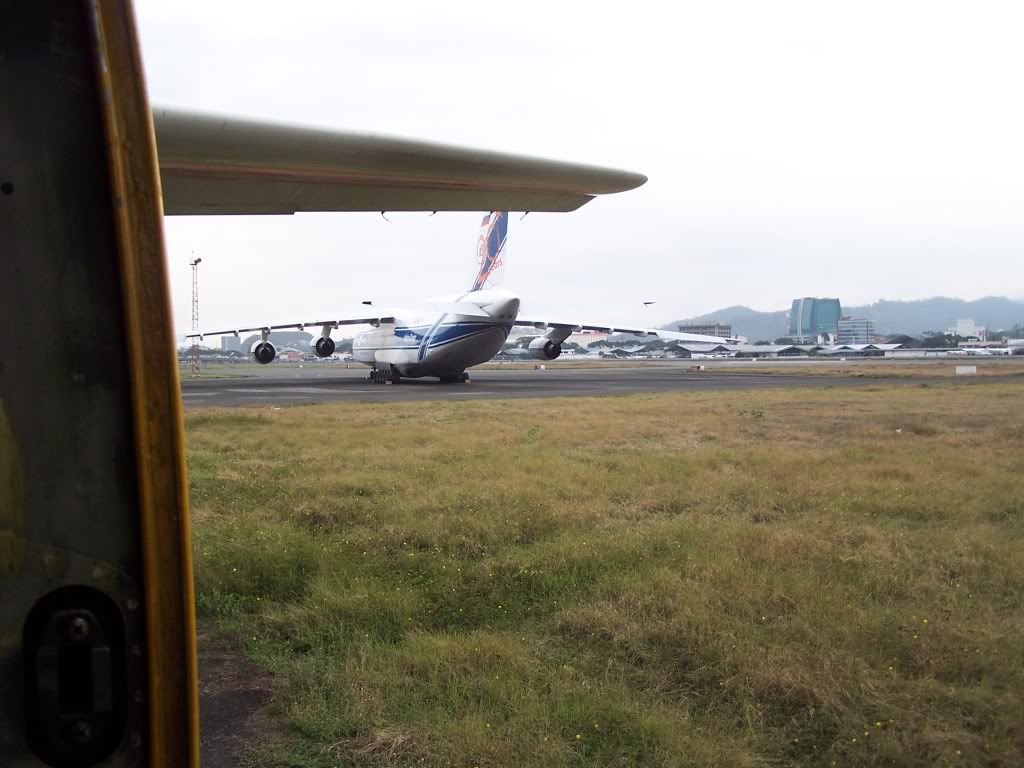 This goddamn huge fucker boxed my C130 in for 2 days and the crew wouldn't come move it. Probably too much vodka.
|
|
|
|
N183CS posted:Postin' an Antonov in a thread about the Cold War. Haha, I remember when that huge fucker was here. What were you doing on that side of the runway? I usually see you all parked on the other side, over on the ramp by the TA building.
|
|
|
|
iyaayas01 posted:Haha, I remember when that huge fucker was here. What were you doing on that side of the runway? I usually see you all parked on the other side, over on the ramp by the TA building. uhh, that pic is from Ecuador. Yeah we almost always park at TA for our pax flights. Only time we go to the far side is when we got splodey stuff on board.
|
|
|
|
N183CS posted:uhh, that pic is from Ecuador. Yeah we almost always park at TA for our pax flights. Only time we go to the far side is when we got splodey stuff on board. ....  For some reason those buildings in the background made me think "downtown Anchorage." Now that I look at it for more than 2 seconds, I see that is clearly not the case. For some reason those buildings in the background made me think "downtown Anchorage." Now that I look at it for more than 2 seconds, I see that is clearly not the case.Anyway, there really was an An-124 here earlier this year, it was hauling some Black Hawks somewhere. And that is indeed where the hot cargo pad is...which for some reason makes me laugh every time I hear it, along with "explosive movement."
|
|
|
|
NosmoKing posted:Rocket fun time! We also have active minuteman III sites stretching from here across Nebraska to the Kansas border. Lastly we have the daddy of all ICBM's the LGM-118 Peacekeeper "MX" missiles in 50 silos. The only ones that were ever made. The cold war was special to me because my main job while in he air force was to guard and control access to these babies. I saw the Berlin Wall fall from a tiny TV screen while on alert. Then watched as other events associated with Perestroika signaled the beginning of the end of the actual cold war.
|
|
|
|
McNally posted:Dad started his career doing propellant transfer on Titan IIs at Little Rock Air Force Base. His stories of that time involve doing repairs on something or other while up to his waist in fuel (for which he earned the coveted title of "steely-eyed missile man"), noxious fumes capable of melting your lungs, and causing pigs to run up hills, making them lose weight and causing the farmer to sue the Air Force. So I went over the story with my dad. Turns out the guy who taught them how to call to the pigs to begin with was the colonel who ended up having to chew them out for it.
|
|
|
B4Ctom1 posted:I saw the Berlin Wall fall from a tiny TV screen while on alert. I knew a guy who was in the Berlin Brigade (US) on 9 November 1989. Says it was the most amazing thing he's ever seen in his life.
|
|
|
|
|
So the "Cold War nuclear strategy We start near the end of WWII. The US Navy at the time had air wings that were split between three main types of aircraft: fighters, such as the F6F Hellcat and F4U Corsair, that were occasionally used for close air support ground strikes (particularly in the case of the Corsair); dive bombers, such as the SBD Dauntless and SB2C Helldiver, that were intended to carry out precision dive bombing strikes against ships and ground positions, with a secondary role as level bombers; and torpedo bombers, such as the TBF/TBM Avenger, that were intended to carry out torpedo strikes against ships, with a significant secondary capability as level bombers against ground targets. Given the advances in technology during the war, the Navy felt that these three roles (ground attack, dive bomber, and torpedo bomber) could be filled by one aircraft that would have high enough performance that it would be able to defend itself and would therefore a) not need escorting fighters and b) could be single seat, not requiring a tail gunner. The prototype Skyraider looked something like this: 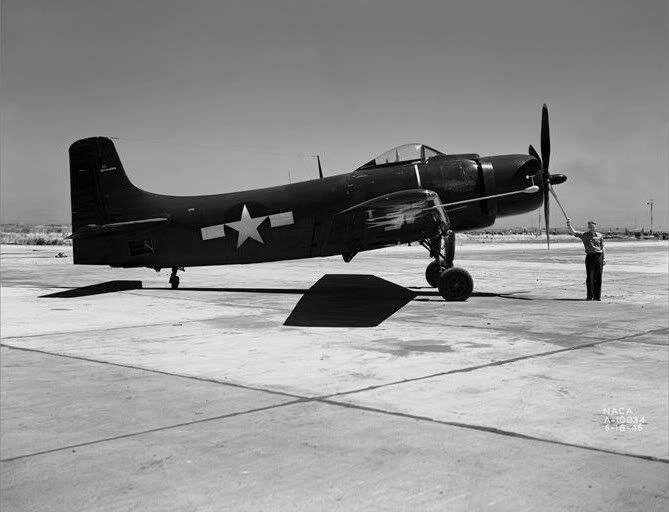 It was powered by a single R-3350 18 cylinder engine generating 2,700 hp (same engine used to power, among other large aircraft, the B-29 Superfortress). It had a rather large straight wing that enabled very good low speed maneuverability, as well as a total of 15 hardpoints (7 per wing and one centerline) that allowed it to carry a ridiculous amount of ordnance: 8,000 lbs worth, the same as a B-17. This wing also gave it a large combat radius and loiter time, especially compared to later jet powered fighter-bombers. Here's a good picture of the Able Dog's (it's first of many nicknames) combat loadout: 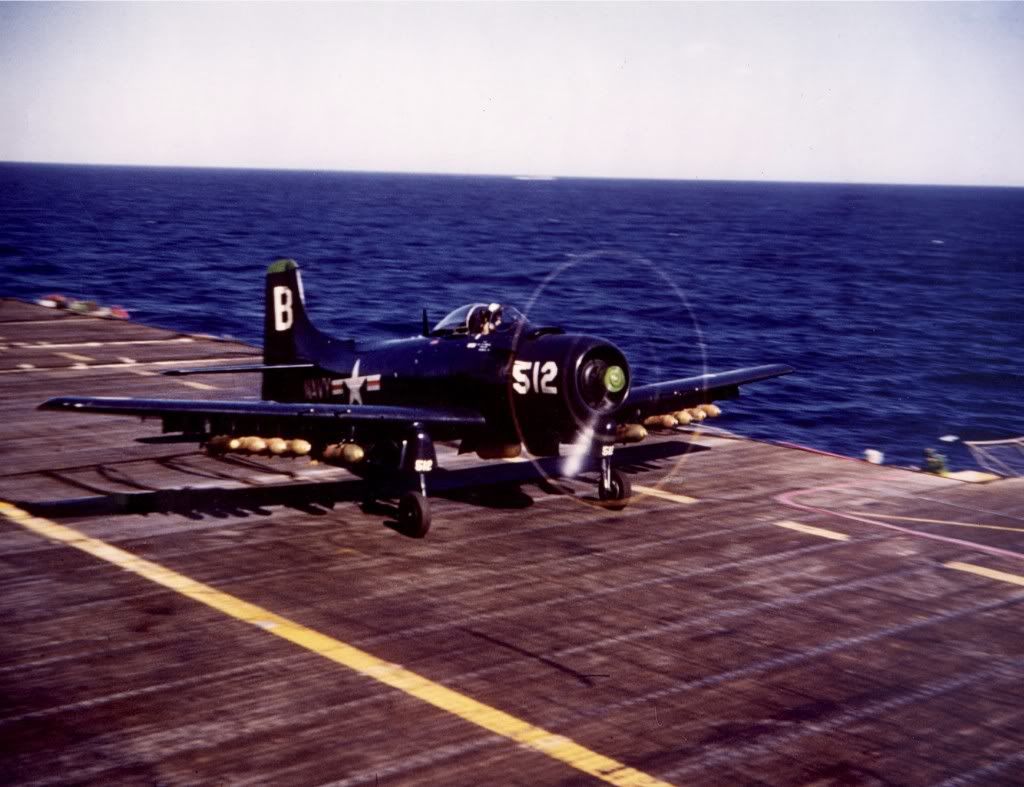 It's painted midnight blue, the color scheme of choice while in Navy/Marine Corps service during the Korea War. There will be a few other color schemes as we shall see. Also, that particular aircraft belongs to VA-195, "The Dambusters." More on that particular nickname in a bit. Before we get to that, it's worth mentioning that the Skyraider fulfilled many other roles besides simple fighter bomber. Among them were electronic countermeasures: 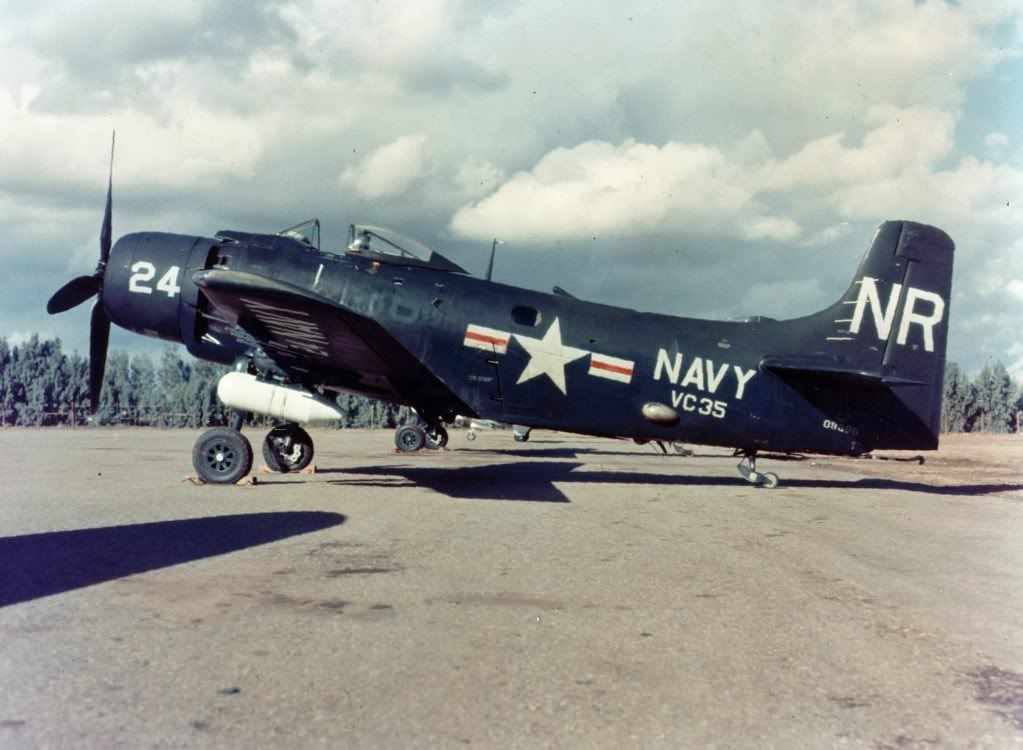 wide body four seat night attack: 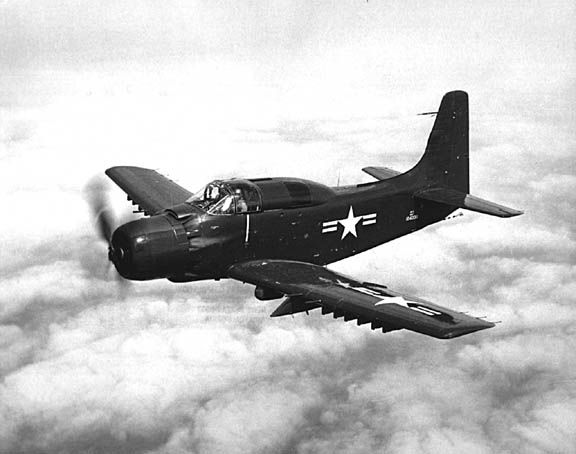 wide body airborne early warning: 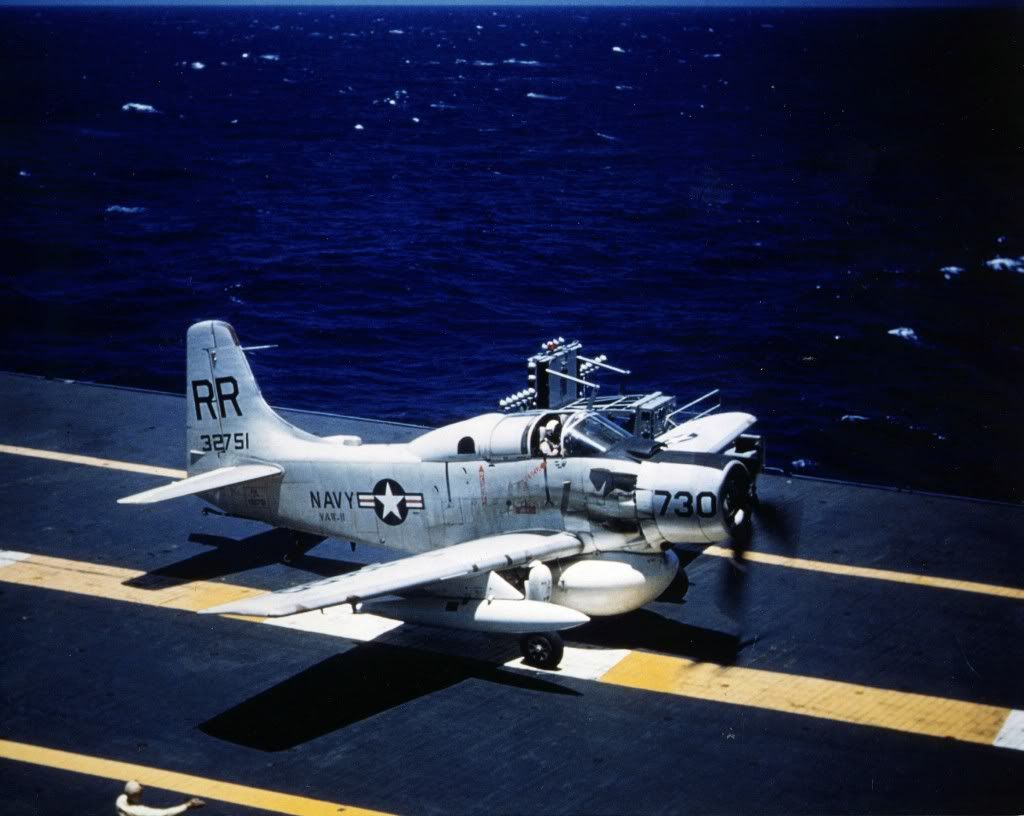 and finally back to single seat attack (featuring the later two tone gray/white paint scheme the Navy adopted in the late '50s and used into Vietnam): 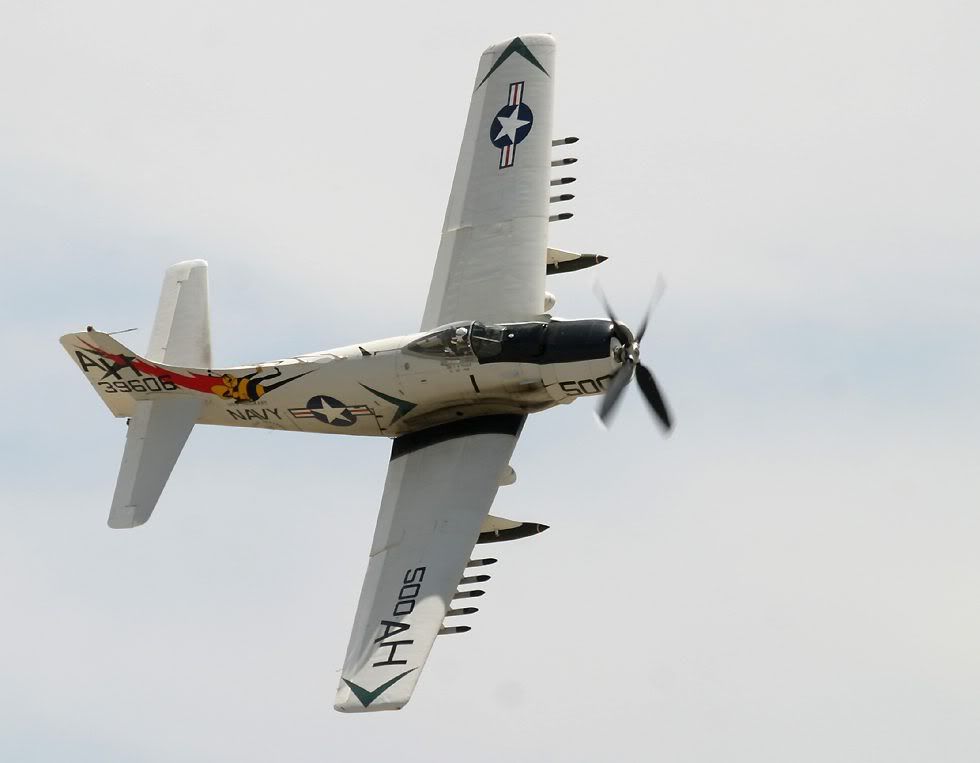 However, before we get too far ahead of ourselves, there are two missions from Korea worth mentioning. The first is the only Skyraider air to air victory of the war. A Marine night attack aircraft managed to shoot down a Po-2 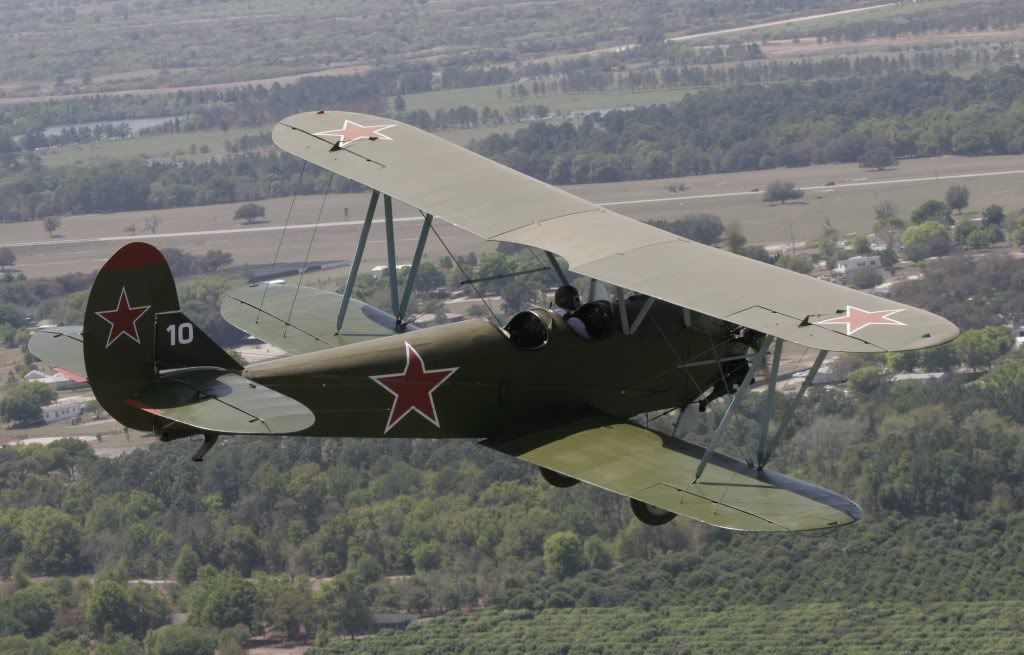 that the Korean People's Air Force would use for night time nuisance raids against UN forces. The UN troops called the aircraft Bedcheck Charlie; they actually managed to cause some serious damage and were quite difficult to shoot down because they were flying at night and the wood and fabric construction of the aircraft made them difficult to locate on radar. The second is the last combat use of aerial torpedoes by the US Navy...on a dam. 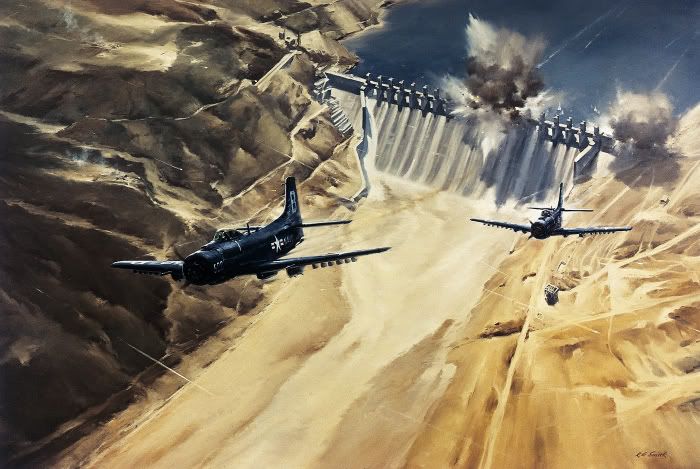 The Hwachon Dam was located across the Han River upstream from Seoul. Chinese forces controlled the dam and were using its floodgates as a weapon, opening/closing them to raise/lower the water level on the river (by as much as 4-5 feet), wreaking havoc on UN efforts to bridge the river as part of a larger offensive. After failing to capture the dam in a combined ground/amphibious offensive across the lake, and failing to disable the gates through a conventional B-29 strike, the task fell to the Navy. The first attempt used conventional 2,000 lbs bombs and 11.75'' rockets; this failed miserably as the bombs only chipped away at the reinforcing concrete while the rockets bounced off of it and careened away. After returning to the ship, the idea to use aerial torpedoes was hatched. There was a slight hiccup in that only a few of the pilots in the squadron had ever been trained in the employment of aerial torpedoes. However, after a quick overnight refresher course, the pilots launched on the mission: 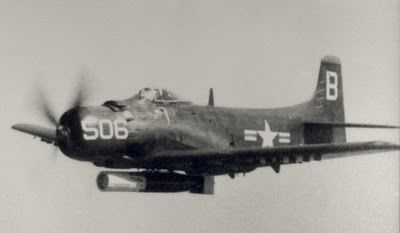 The results were a solid 6 out of 8 hits, resulting in destroying several of the dam's floodgates and removing the ability of the Chinese to control the river level. 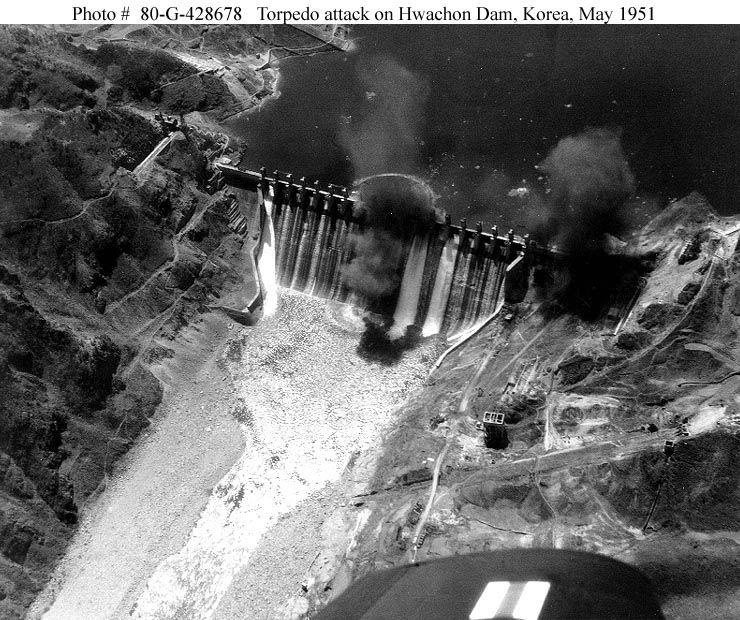 And thus VA-195 (now VFA-195) earned the nickname "The Dambusters," still used to this day. Before we move on to Vietnam, VA-195 also had another claim to fame during the Korean War...while other units dropped everything except the kitchen sink over North Korea, VA-195 went the extra mile and dropped that too: 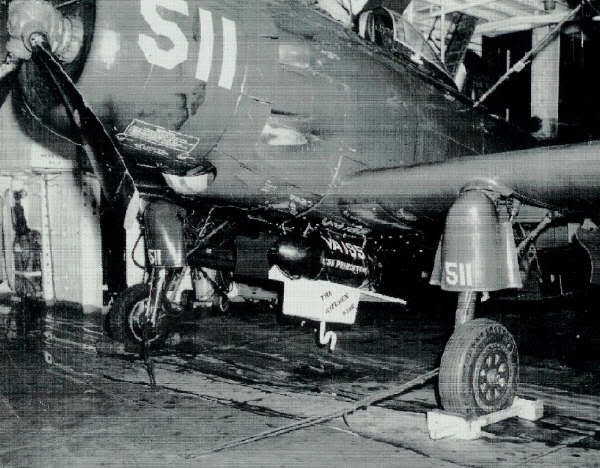 Unlike those jokers with the toilet bomb during Vietnam, VA-195 wasn't kidding around...that's a 1,000 lbs bomb attached to the toilet. They meant to do some damage when they dropped it over Pyongyang in 1952. The Skyraider remained in service with the Navy/Marine Corps post Korea, seeing a bit of action in 1954 when they engaged a couple of Chinese WWII era La-7 fighters while searching for survivors of a downed civilian airliner, shooting down two of the Chinese fighters. In the early '60s, the U.S.'s involvement in Vietnam began to heat up; while Skyraiders were slated to be replaced by jet powered aircraft (primarily A-4 Skyhawks and all weather A-6 Intruders) they served admirably in the early years of the war, taking part in the first strikes after the Gulf of Tonkin Incident. The Navy Skyraiders even managed to shoot down 2 jet engined North Vietnamese MiG-17s that had the bad luck to happen in front of its 4 20mm cannons. However, even before the war started, the Navy had begun to transfer their A-1s to the VNAF. By 1968 the Navy had withdrawn all of its Skyraiders from service, but they still had much to do with the VNAF and, gradually, with the USAF. 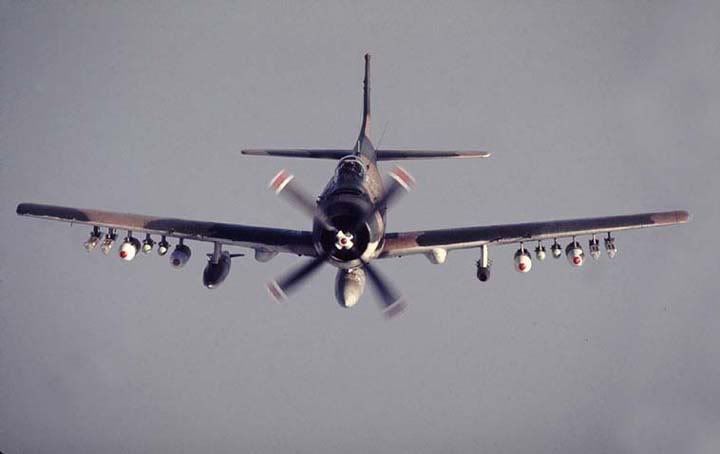 (Can't see it well, but this aircraft is wearing the standard USAF three shade green/tan camouflage pattern that it adopted later in the war). As mentioned previously, the Skyraider possessed good low speed maneuverability and a large combat radius/long loiter time, especially compared to the jet engined fighter-bombers of the time. Additionally, the Skyraider was designed from the start to incorporate armor to protect vulnerable areas (mainly the engines and flight controls). As it began to be used for more hazardous RESCAP missions (more on that in a bit) the areas that were armored began to increase, to also protect the pilot. The end result was that the Skyraider was able to limp back to base with some pretty serious battle damage:  These characteristics (low speed, long loiter time, large ordnance load, and survivability) meant that the Skyraider was uniquely qualified to serve in one of the most hazardous duties during the war, which was to be the RESCAP (Rescue Combat Air Patrol) escort for the Jolly Green Giant helicopters that would go deep into enemy territory to pick up downed pilots. The call sign for the escorts on these missions was Sandy, which became another one of the Skyraider's many nicknames. 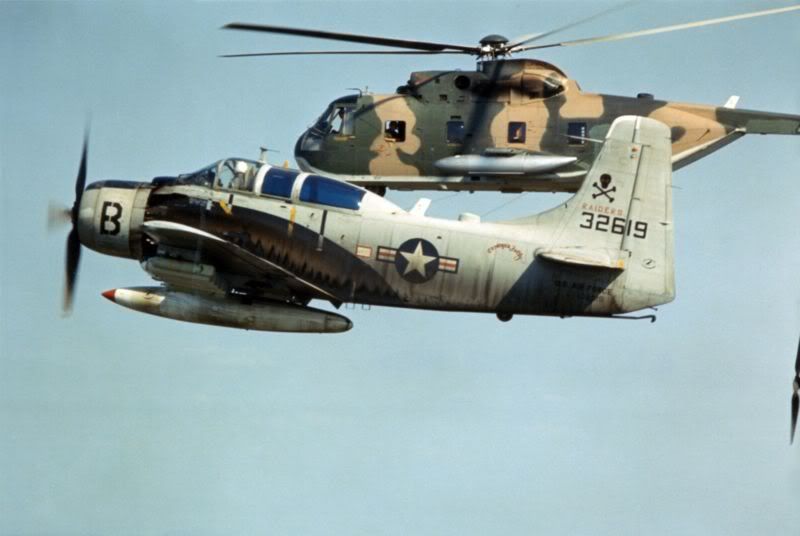  HH-3 Jolly Green Giant rescue helicopter and "fat face" Skyraider..."fat face" was the nickname given to the AD-5/A-1E models that featured side by side seating. The USAF/VNAF operated both types:  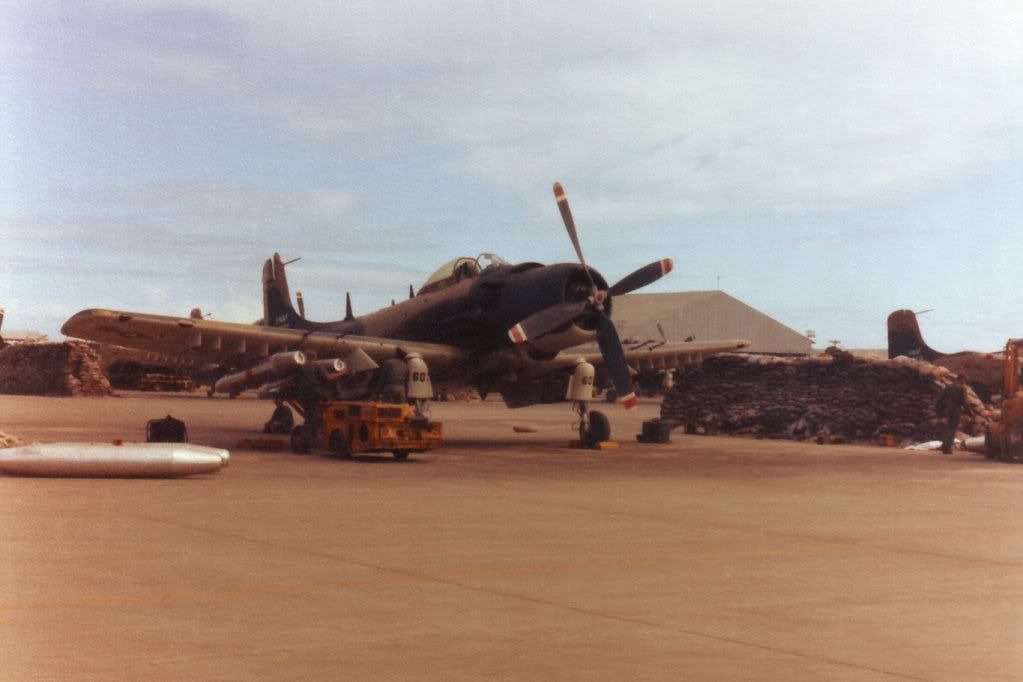 One of the most famous "fat face" Spad (another one of the Skyraider's nicknames, this one in honor of its slow speed) missions was that of Major Bernard Fisher, for which he was awarded the Medal of Honor. Major Fisher and his wingman were engaged in close air support at the A Shau special forces camp, that was under a determined attack from a few thousand NVA regulars. The hostile troops had taken control of the airstrip when Major Fisher's wingman suffered a critical hit and was forced to crashland on the enemy infested airstrip. Major Fisher elected to land on the enemy held airstrip and taxi the length of it to pickup his wingman. While under withering enemy fire (his aircraft was struck 19 times while on the ground) he managed to get enough airspeed to get airborne from the runway overrun area. 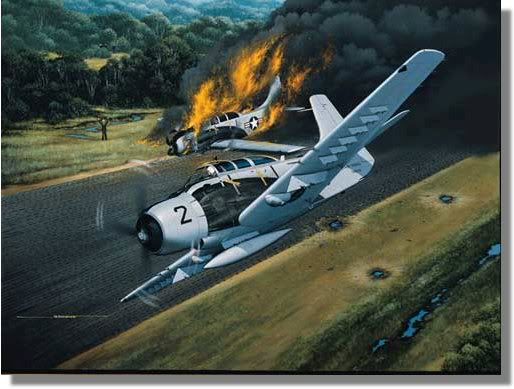 Big brass ones. An interesting postscript to that story is that the very airframe that Major Fisher was flying has actually been preserved and is on display at the National Museum of the US Air Force: 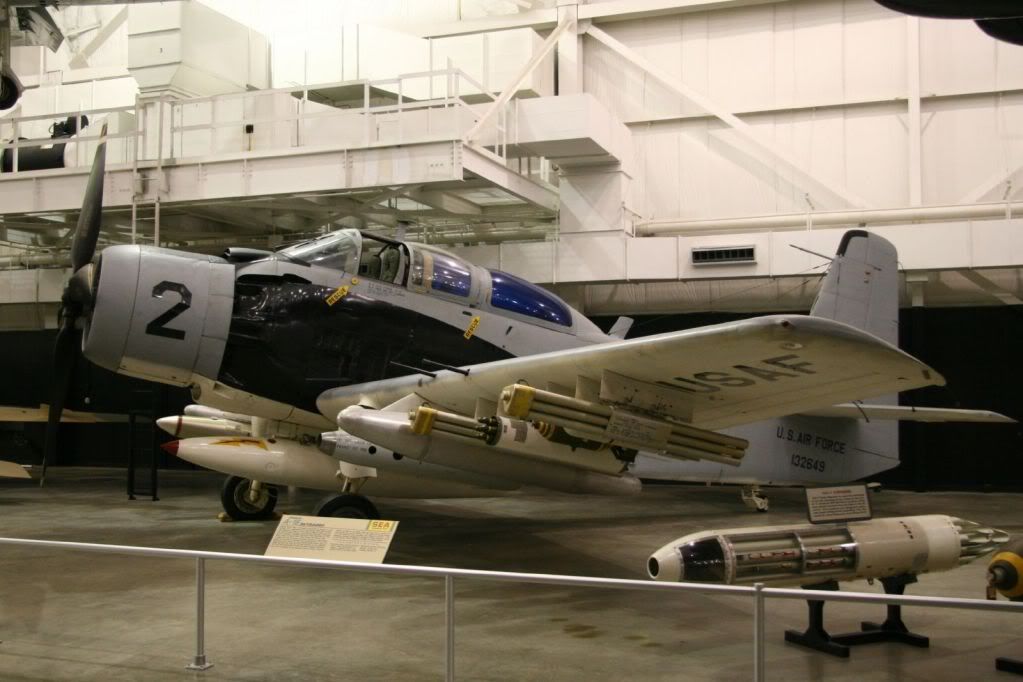 Anyway, enough about the Skyraider. Even as Vietnam was on going, there were those in the Air Force that recognized a serious problem with its current inventory. Its only truly effective ground attack/air support aircraft was a WWII era reciprocating engine design. All the aircraft it had developed over the past two decades were quite unsuited for the mission, both due to their excessive speed and their lack of combat survivability. Additionally, the Soviet Army was not getting rid of its sizable armor force anytime soon and the Army's current fleet of attack helicopters (UH-1 Huey and its offspring, the AH-1 Cobra) was quite unable to deal with any sort of armor, since they were armed only with small arms caliber machine guns and unguided rockets effective against soft targets (this issue would eventually be partially solved with the development of the TOW missile and AH-64 Apache attack helicopter). This led the Air Force to release an RFP calling for an aircraft with low speed maneuverability, long loiter time, a large ordnance load as well as a large cannon, and great survivability. In effect, the RFP was combining the best features of the Skyraider, the Soviet Il-2 Shturmovik, and the German Hs 129 Panzerknacker. That's all I have time for now, tune in next time to hear the rest of the A-X and A-10 saga.
|
|
|
|
Unrelated to the above, but kinda cool...happened across this picture earlier tonight: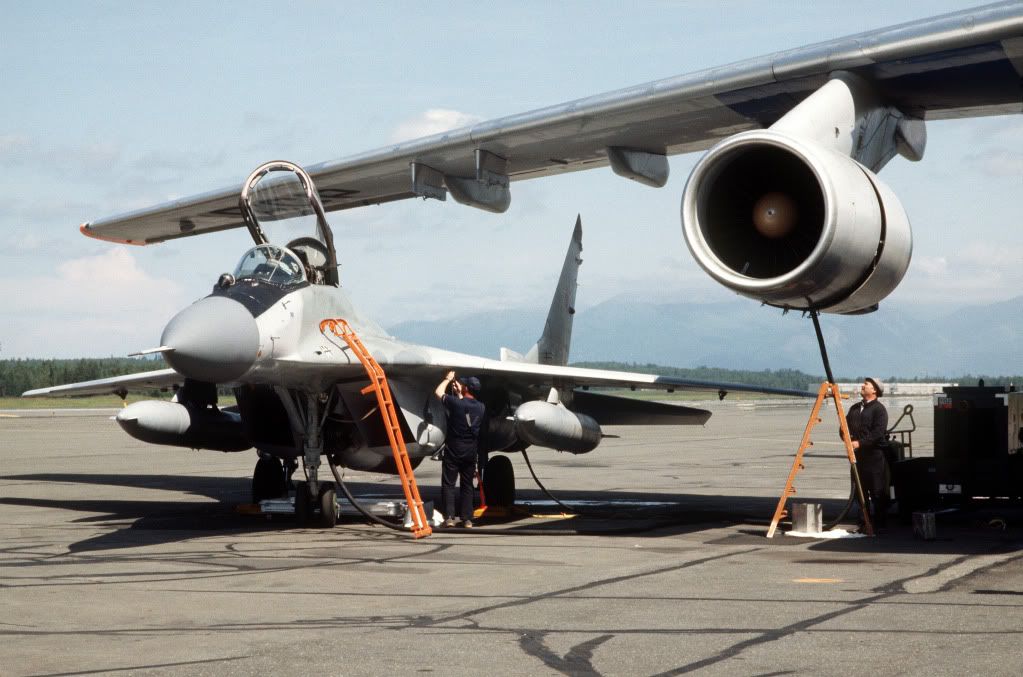 It's of a MiG-29 refueling from an Il-76 on the ground...at Elmendorf AFB...in 1990, as they were all on their way to that Canadian airshow. Check out that dude on the right wearing a loving fedora on the flightline. Also, I know exactly where they are parked, and holy crap this base has done some serious expansion since then.
|
|
|
|
Thread continues to own. Some wicked photos, too!
|
|
|
|
Planes are awesome. This thread has been a ton of fun to read.
|
|
|
|
The A-10 fratricide derail in the Photo thread, IIRC, reminds me of something. Since patriot downed the USN F-18 and RAF Tornado, our training has gone from "trust the system" to "question everything the system tells you ever" and included a ton of software overhauls related purely to fratricide, as well as a bunch regarding ballistic missile defense planning and engagement. The result is now that when we work with the Air Force, they're mostly happy with us, aside from the odd snarky comment about going "11 for 9" in OIF (we shot down 11 targets, only 9 were legitimate). The Marines, on the other hand, are always inviting us to the big ground/air integration course, Weapons Tactics Instruction, and seem to get pretty butthurt when we don't just start shooting down anything that looks at us funny. Then they'll create self-defense criteria for Patriot that we know won't work and it gets leaked to the red force pilots by other Marines. So they fly just a hair too slow or too high or whatever for us to engage them without authority, and the game turns into us screaming for permission to shoot down the F-5 about to bomb us to hell. RIGHT AFTER it has flown by, bombed us, and strafed the command center, they tell us to engage it, but we can't because it's behind us now. Things run much better with an AWACS around. We've gotten to the point, it seems, where we'd rather see red air come blow apart a few buildings on the ground than risk having 1 or 2 pilots be killed by Patriot. Yes, all fratricide is awful, but if you applied the restrictions to CAS that they do to Patriot, you'd pretty much cease to have CAS. During my last trip to WTI, we pointed out that they hadn't given us proper self-defense allowances to let us shoot at the TV-guided missiles the enemy would be launching at us, which were simulated by this little guy splitting off from an enemy craft: http://www.youtube.com/watch?v=SR9bgiZizAA&feature=related#t=1m29s A Marine captain, intent on letting all of us other captains know he would soon be a major, called out "You're telling me you'd let something going fast right at you hit you if you didn't have express permission to shoot it?!" We let it slide during the massive brief, but when he came to berate us afterward, we asked him to go ask the British course manager how things go when Patriot just starts shooting at stuff that looks scary. He left in a huff, but acknowledged that maybe the self-defense criteria was crap. By the way, I have yet to go to a WTI where a Marine stinger team doesn't shoot down a friendly at some point. A photo for your time:  Note the attitude control motors on the nose of the PAC-3 interceptor firing immediately at launch to help steer it toward its target. Most of these motors are saved for the end-game to make precise corrections and ensure the interceptor strikes the warhead of the missile and not just the body. mlmp08 fucked around with this message at 01:46 on Nov 20, 2012 |
|
|
|
iyaayas01 posted:In effect, the RFP was combining the best features of the Skyraider, the Soviet Il-2 Shturmovik, and the German Hs 129 Panzerknacker. Wouldn't the Ju-87G be more analagous to the A-10 RFP than the Hs-129?
|
|
|
|
Semi off-topic, sorry: mlmp08 what do you think of the feasability of ICBM defense as is being pushed right now? I've heard a lot of different opinions on it and you seem to be quite well informed.
|
|
|
|
mlmp08 posted:Yes, all fratricide is awful, but if you applied the restrictions to CAS that they do to Patriot, you'd pretty much cease to have CAS. Airplanes cost more than soldiers.
|
|
|
|
McNally posted:Airplanes cost more than soldiers. As do pilots. The US went with either single warhead ICBM's with the RV just stuck on the front of the missile, or they went with MIRV's where the RV had a shroud around the RV's. The shroud was removed in space with teeny rocket motors that would pull it away from the bus as well as move it out of the way of the RV's. The soviets did it a different way in many of their ICBM's (especially earlier MIRV's). The RV's are mounted on the OUTSIDE of the nosecone of the bus. I'll see if I can get a good scan of what that looked like soon.
|
|
|
|
AlexanderCA posted:Semi off-topic, sorry: I'll preface this by saying that my focus as traditionally been on SRBM and some MRBM and I tend only to look at ICBMs as far as how they tie into the big picture. Being a Patriot guy who also has to care some about THAAD and Short-range systems like Avenger and SLAMRAAM doesn't afford me a ton of time to worry about ICBMs, though with our new upper-tier adafco slots, maybe that will change. ADAFCO=Air Defense Artillery Fire Control Officer. First, take this little graphic from the Missile Defense Agency:  Anyway, ICBM defense and what we have now can be evaluated by a couple of metrics. First, there is the idea that nothing anyone can launch at us will hit us. That's just ludicrous. If Russia really completely lost their loving minds and decided to strike us, there's not a whole hell of a lot we could do about it. Some laymen seem to think that that's what THAAD and Patriot and Aegis are for (haha). The metric that most who understand the system go by is that we need to ensure a rogue state like North Korea or a rising state like Iran be thwarted by our missile defenses. Detection, as it stands now, is pretty good. Overhead persistent infra-red (OPIR) is a system of satellites which can detect, track, and predict flight paths of missiles as they are launched. ICBMs are the easiest to detect, as they burn longest and hot. SRBMs are harder, but can still be tracked pretty well. Lower burn time, worse atmospheric conditions, etc. can make things harder to detect. We also have forward-based AN/TPY-2 suveillance radars which are extremely powerful and have just fantastic fidelity considering the ranges at which they are working. They are also very expensive, vulnerable, and take a lot of service and support to operate. The Air Force also operates very powerful radars like Cobra Dane and others. The big hitter we'd love to have but just don't is the ability to intercept ICBMs and other missile during the boost phase. We tried the Airborne Laser, which was a big laser on a 747 frame, and we decided it was just one more high-value air asset (HVAA) to defend, very expensive, had limited range and flight time, and would be required to fly in very dangerous areas where enemy fighters or SAMs could wreck it. It has been scrapped. In mid-90s, the air force tested a kinetic kill missile that would be launched by F-15s standing by for missile launches, but it was again decided that they would be too vulnerable and would require a stupid amount of fighters on ICBM duty to get anything done, and the range wasn't fantastic. In the present and immediate future, the sensors we have and the ground-based interceptors (GBI) operated out of Mt. Cheyenne will be enough to deal with North Korea's or Iran's one-day in the future ability to launch a very limited number of ICBMs. The holy grail would be some sort of ultra-fast, highly accurate, long range ground-based interceptor or else some sort of UAV which can loiter for a very long time at very high altitude and launch an interceptor. Or pew pew lasers with extreme range. But wait, why is killing the missile in the boost phase so important?! Many reasons. Note that from here I won't be talking specifically ICBM. Using Patriot for ICBM defense is not a good idea. 1. Missiles aren't employing countermeasures in the boost phase. ICBMs can deploy a bunch of decoys in midcourse while they are exo-atmospheric which can make it hard to hit the right warhead and, almost as bad, make it very hard for missile defenders to know if they hit the right warhead or not. This can be a big problem for Aegis when engaging in midcourse. Once the warhead(s) and decoys hit the atmosphere, it becomes much easier to tell what is a big heavy warhead and what is a fake, lighter decoy. This is where THAAD and, later, Patriot come in. THAAD shines in that it can hit targets right after decoys start to fail, but before submunitions are released (MRBM and SRBM, mostly. ICBMs that utilize MIRV tech while exo-atmospheric are tricky). When I talk submunitions, I mean cluster bomb warheads, chemical submunitions, runway penetrator cluster weapons, etc. Obviously, if you hit them while boosting, you don't have to worry about any of that at all, yay. 2. Each missile you track is sucking up radar resources. The longer a missile is on scope flying around the world, the more resources from multiple sensors you're using which can make it harder to detect new missile launches or maintain track of detected missiles. 3. An early intercept ought to be very easy to assess as hit/miss. Firing midcourse into a cloud of debris and decoys can be hard to assess, meaning you're tying up resources either re-engaging it or trying to figure out if you hit it. 4. It would free up other radars to search launch areas more closely. If you could be certain that you could hit, say, 90% of missile fired from a specific launch area during the boost phase, you could tell other surveillance or fire control radars not to worry about that area so that they could focus more of their energy (literally) on searching ballistic missile operations areas (BMOAs) that you can't cover, resulting in earlier detection and better probability of kill by Aegis, THAAD, or Patriot. In case that last point didn't make sense, we don't just turn on a Patriot radar or THAAD radar or Aegis radar and let it look for things. We tell the radar what assets we care most about, where we think missiles will come from, and what type of missiles we expect to see. From there, the software optimizes the best way to search for the highest threats. Given this system, it is very important to have good intel and only defend the most critical items so that you don't end up with late detection because you're overloading the radar trying to search for everything everywhere. 5. Shooting down a missile in the terminal phase can result in a pile of clutter and chaff and debris hanging out right over top your terminal defense radars, seriously degrading your ability to detect or destroy later volleys. Luckily, Patriot is pretty damned good at dealing with this, but some other sensors aren't and it's still not ideal. so, uh, wall of text.
|
|
|
|

|
| # ? Apr 27, 2024 02:16 |
|
On the topic of air and missile defense systems. There's a programmer who has been building SAM simulators for SA-2,SA-4, and SA-4 air defense systems. http://sites.google.com/site/samsimulator1972/ What I like most about the software is it shows how difficult and complicated these systems really are and as such how important training was in the use of these systems.
|
|
|

